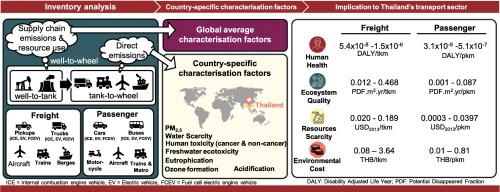Spatially differentiated life cycle assessment of Thailand's transport: The implications from country-specific factors and alternative technologies
IF 9.6
1区 环境科学与生态学
Q1 ENVIRONMENTAL STUDIES
引用次数: 0
Abstract
This study proposed country-specific characterisation factors (CFs) for Thailand by modifying the Thai Spatially Differentiated Life Cycle Impact Assessment (ThaiSD) method and introducing monetary conversion factors to express environmental impacts in Thai Baht. Five impact categories were fully parameterised, including fine particulate matter formation (PMF), human toxicity (both cancer and non-cancer) (HTc and HTnc), freshwater ecotoxicity (FET), and water scarcity (WS). Other spatialised CFs were selected from regionalisation models in ReCiPe2016 and IMPACT World+. When comparing the use of country-specific CFs with global average, the impact scores for PMF, HTc, HTnc, FET, photochemical ozone formation and terrestrial acidification demonstrated notably different levels, ranging from ±25 to ±50 %. The developed method was then applied to assess environmental impacts and costs of Thailand's transport sector, encompassing freight and passenger transport across roadway, railway, waterway, and aviation. Climate change (CC) was significantly attributed to human health and ecosystem quality impacts, while the major contributor to resource scarcity impact was fossil resource scarcity (FS). In some scenarios, non-exhaust emissions, particularly from freight trucks, accounted for 40–60 % of the total PMF impacts. Environmental costs of freight and passenger transport in Thailand were 0.08–3.64 Thai Baht per tonne-kilometre and 0.01–0.81 Thai Baht per passenger-kilometre, respectively. Among transport modes, trains were found to be the most environmentally favourable option for both passenger and freight transport, while aviation had the highest environmental impact for freight transport. In contrast, passenger aviation had a comparable environmental burden to passenger cars due to optimised occupancy rates. Despite the efficiency of modern internal combustion engine vehicles (ICEVs), particularly Euro 5 and 6, employing blended biodiesel was less effective in comparison to conventional diesel. Battery electric and fuel cell electric vehicles offered advantages in mitigating CC, PMF, and FS compared to ICEVs, although trade-offs remained across other impact categories.

泰国交通的空间差异化生命周期评估:来自特定国家因素和替代技术的影响
本研究通过修改泰国空间差异化生命周期影响评估(ThaiSD)方法,并引入货币转换因子以泰铢表示环境影响,提出了泰国的具体国家特征因子(CFs)。五个影响类别被充分参数化,包括细颗粒物形成(PMF)、人类毒性(癌症和非癌症)(HTc和HTnc)、淡水生态毒性(FET)和水资源短缺(WS)。其他空间化的cf是从ReCiPe2016和IMPACT World+的区域化模型中选择的。在将国别国别碳排放指标的使用情况与全球平均水平进行比较时,PMF、HTc、HTnc、场效应效应、光化学臭氧形成和陆地酸化的影响得分显示出明显不同的水平,范围从±25%到±50%。然后将开发的方法应用于评估泰国运输部门的环境影响和成本,包括公路、铁路、水路和航空的货运和客运。气候变化对人类健康和生态系统质量的影响显著,而对资源稀缺性的影响主要是化石资源稀缺性。在某些情况下,非废气排放,特别是货运卡车的排放,占PMF总影响的40 - 60%。泰国货运和客运的环境成本分别为每吨公里0.08-3.64泰铢和每乘客公里0.01-0.81泰铢。在各种运输方式中,火车对客运和货运都是最环保的选择,而航空对货运的环境影响最大。相比之下,客运航空的环境负担与乘用车相当,因为客座率达到了最佳水平。尽管现代内燃机车辆(icev)效率很高,特别是欧5和欧6,但与传统柴油相比,使用混合生物柴油的效率较低。与icev相比,电池电动汽车和燃料电池电动汽车在减轻CC、PMF和FS方面具有优势,尽管在其他影响类别中仍存在权衡。
本文章由计算机程序翻译,如有差异,请以英文原文为准。
求助全文
约1分钟内获得全文
求助全文
来源期刊

Sustainable Production and Consumption
Environmental Science-Environmental Engineering
CiteScore
17.40
自引率
7.40%
发文量
389
审稿时长
13 days
期刊介绍:
Sustainable production and consumption refers to the production and utilization of goods and services in a way that benefits society, is economically viable, and has minimal environmental impact throughout its entire lifespan. Our journal is dedicated to publishing top-notch interdisciplinary research and practical studies in this emerging field. We take a distinctive approach by examining the interplay between technology, consumption patterns, and policy to identify sustainable solutions for both production and consumption systems.
 求助内容:
求助内容: 应助结果提醒方式:
应助结果提醒方式:


